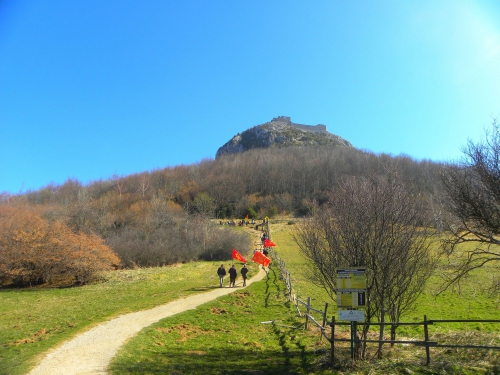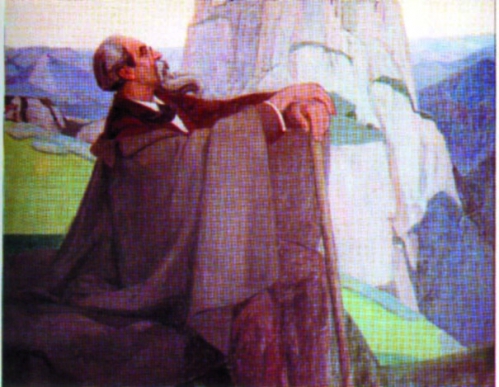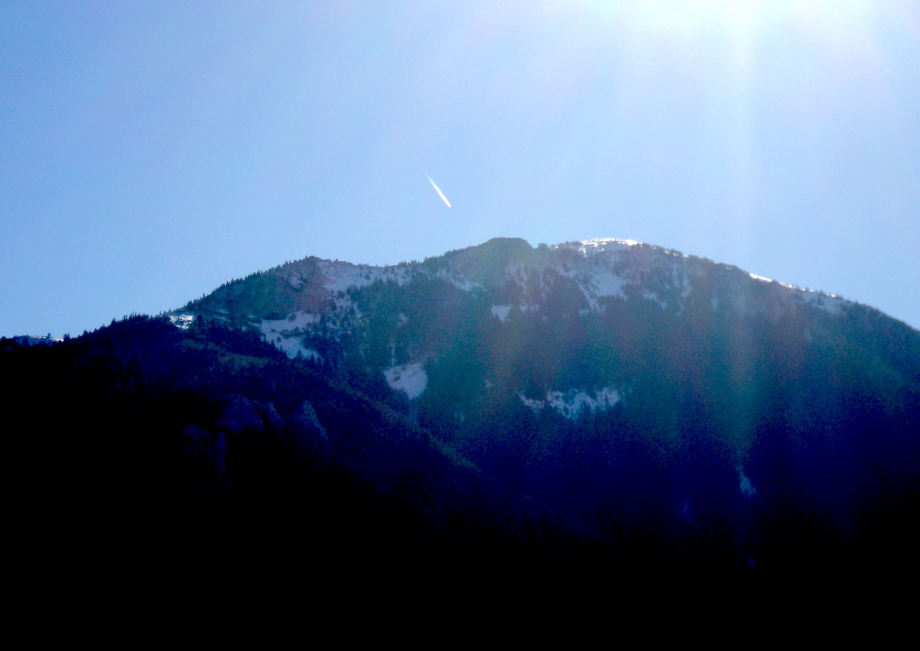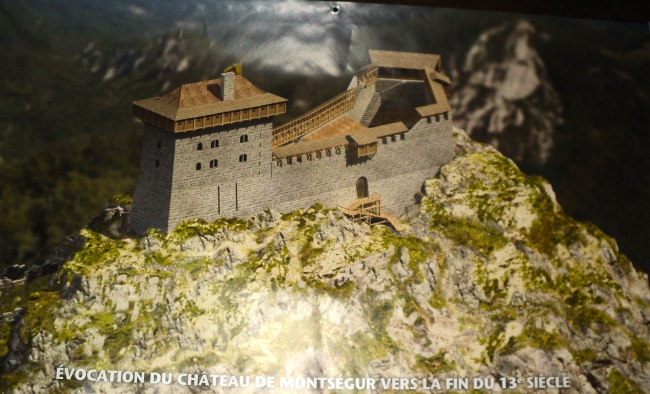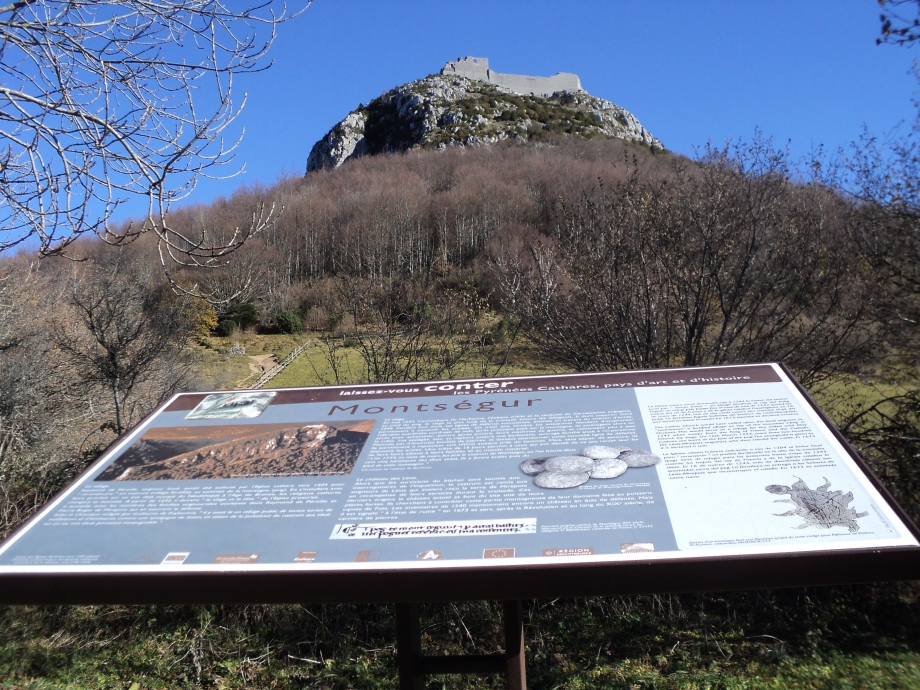ADVENTURES - Montségur
This ruined castle called Montségur in Ariège has become a symbol to Occitan people, and to many others, of the tragic fate of the Cathars. Pilgrimages are made there every 16th March, the anniversary of the Cathars terrible fate in 1244, when more than two hundred people were burned alive on a fire of fierce burning brushwood and pine logs. It's said they went willingly to the deaths, singing Cathar hymns.
Only 63 people were listed among the 200-odd, those who were Perfects or who had aristocratic descent. The people living at the castle who were servants or soldiers and not Cathars, were let go. There was no battle at Montségur. The castle had been besieged for over a year but the inhabitants surrendered, it's thought because their water supply was poisoned, and they were alllowed two weeks to get their affairs in order, during which they managed to smuggle out the Cathar treasure. The story, in much more detail, and the truth about the treasure, features in my book, Usson, Pyrenean Castle. Click the Link!
In March 2014, people came from far and wide to assemble at the foot of the mountain.
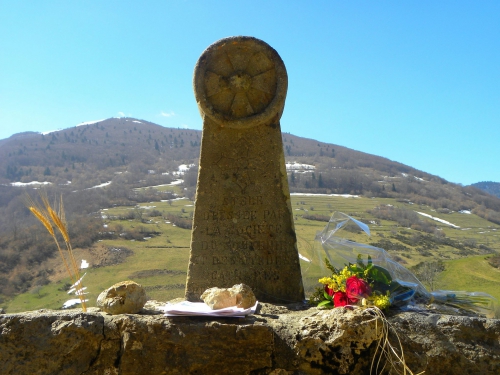
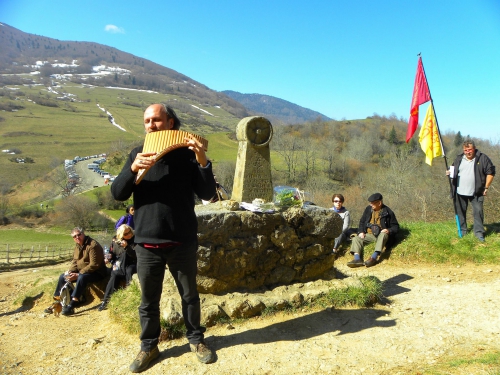
They gathered around the stèle, erected so long ago by Déodat Roché, in May 1961, to remember, with tears in their eyes, those who died in this place. It is now, some say, forever haunted. The field is called Camp de Cremat - Field of Burning - to this day. Richard Stanley, who actually lives in the modern (well, younger than 12th century) village of Montségur, took these photos on 16 March 2014, 770 years after the event, and lent them to me for which, many thanks.
He had spent the previous night in a lonely vigil for the souls of the dead. As he climbed up to the castle a storm was brewing and all was in darkness as he braved the wind and climbed up the steep path. It was so dark even his modern camera could perceive little in the blackness. He settled in the courtyard that he knows so well and sensed various spirits around him . . . about 3am a full white moon rose and kept him company, like a goddess. The storm went silent. Then he went down to meet up with the others at the stèle.
The man who was my previous life, Jules Azéma, must have gone to Montségur. Through his Occitan poetry, he knew Déodat Roché, and was even closer friends with the great Occitan educator, Prosper Estieu. Here's a contemporary portrait of Prosper at the foot of Montségur.
The mountain with its castle was a great symbol to the Occitan poets, evoking the "men from the north" who had taken away from them their heritage and religion.
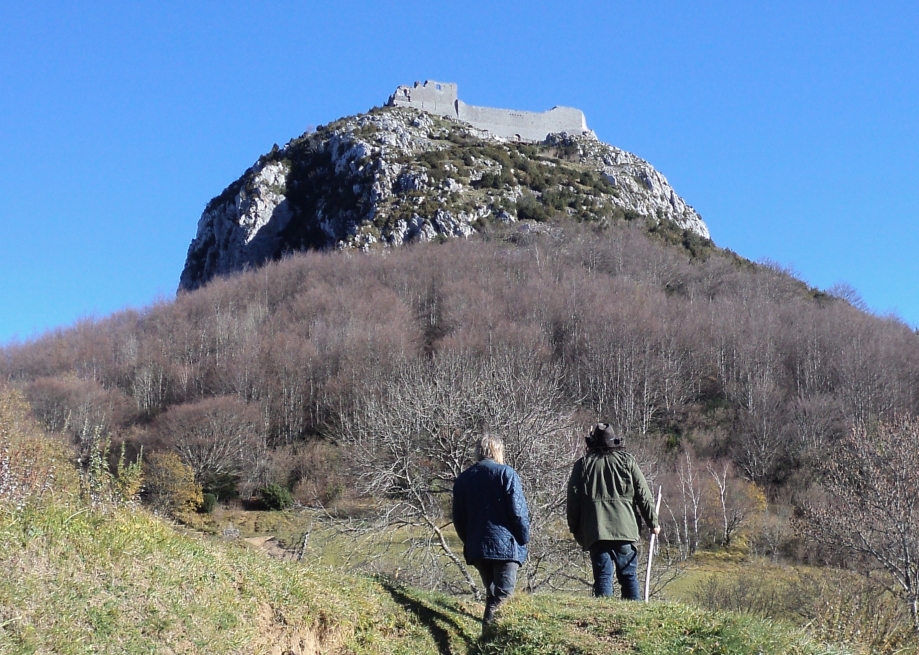
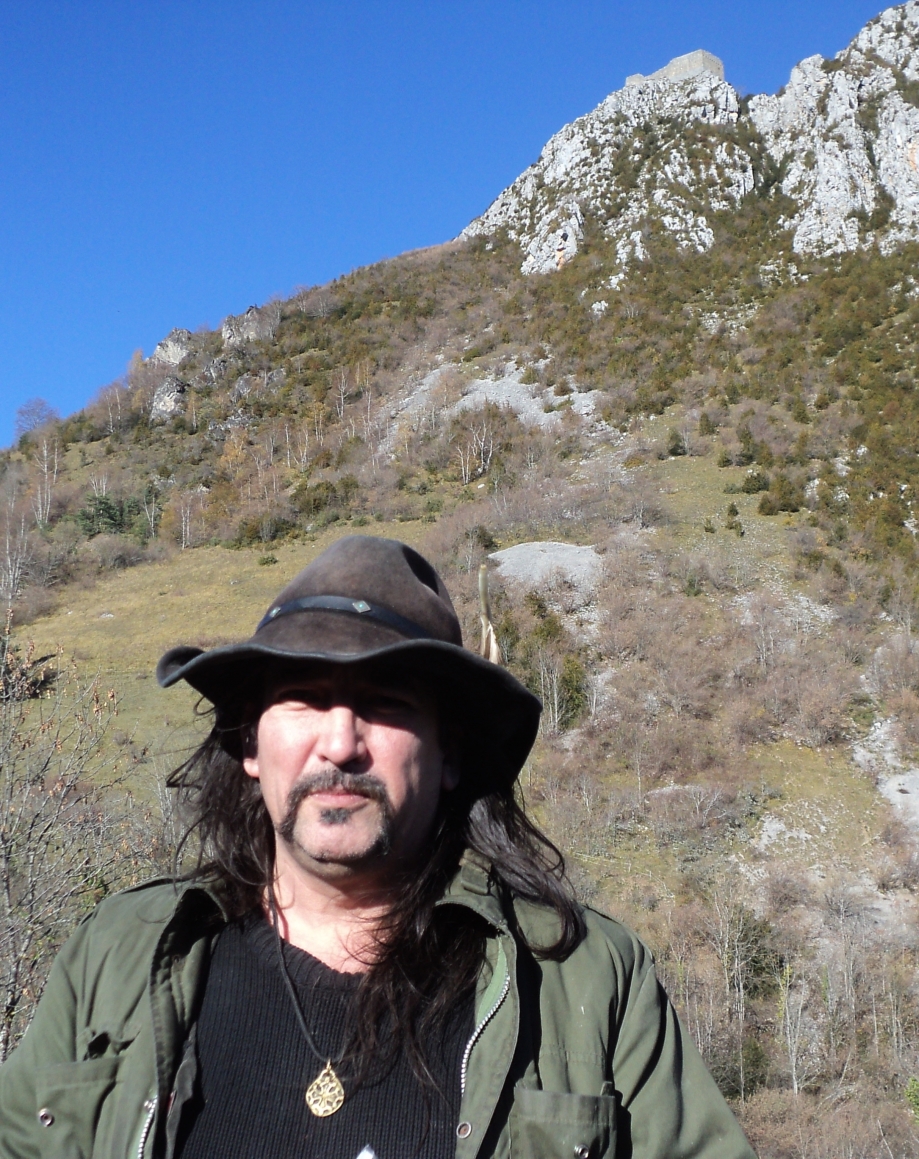
The classic view of the Montségur mountain. Portrait of Richard, the castle tiny in the background
In December 2015 I went to visit Richard Stanley, thanks to the courtesy of my friend Jeremy.
That beautiful sunny day Richard told us that 100,000 people come annually to Montségur but most of them just climb the mountain to see the castle and neglect the village below. That day I did not want to climb up to the castle and in fact I have never wanted to. This could be something to do with the Azémas like Guillaume Azéma of course. (Click here for details of Guillaume.) And I do have some good pictures of the castle, thanks to my friend Keith Ashby.
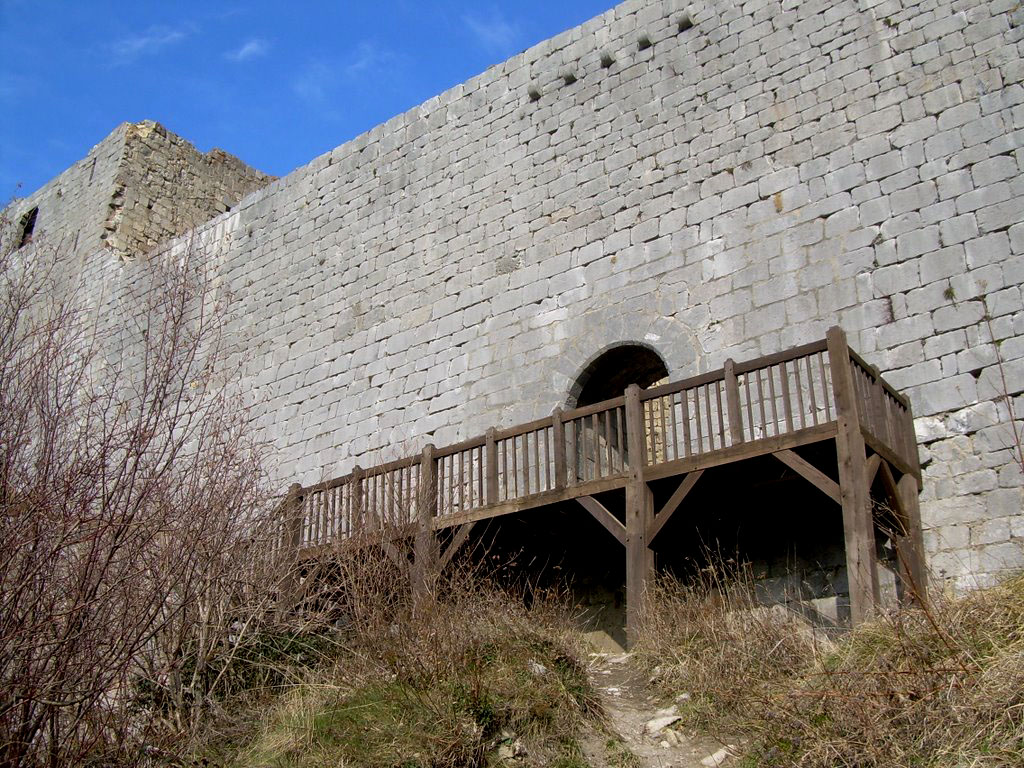
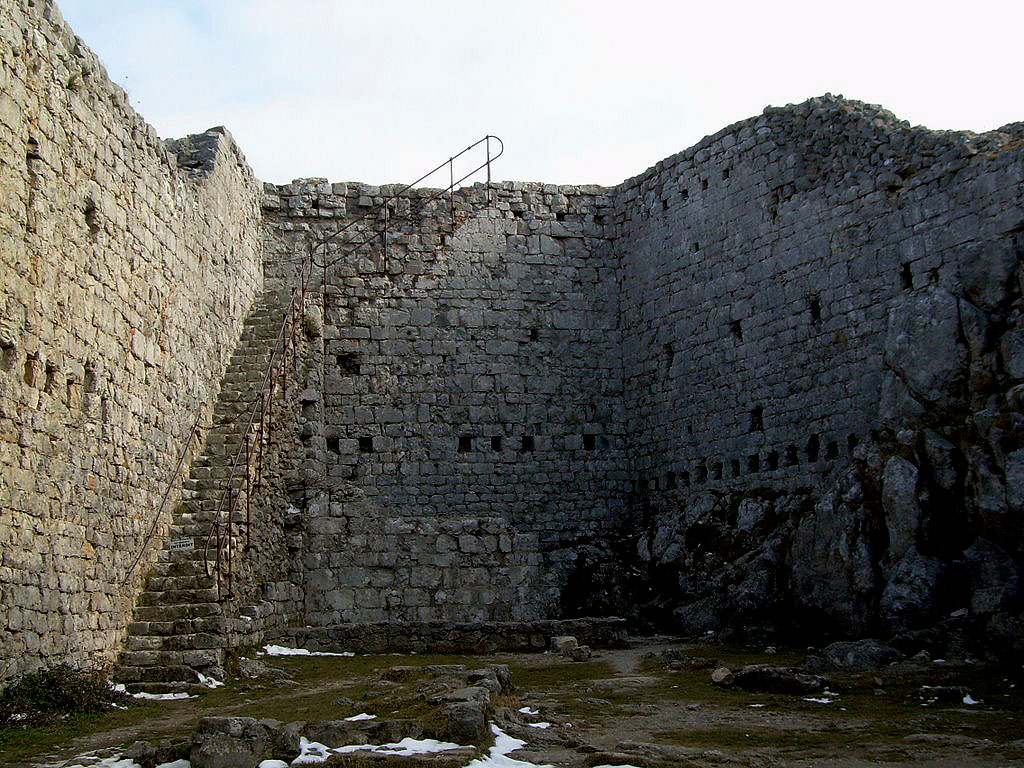
For myself the village was what interested me. But first I just wanted to see and touch the stèle to the Cathar Martyrs, erected in the 1960's when Occitan studies were starting to "come into their own." 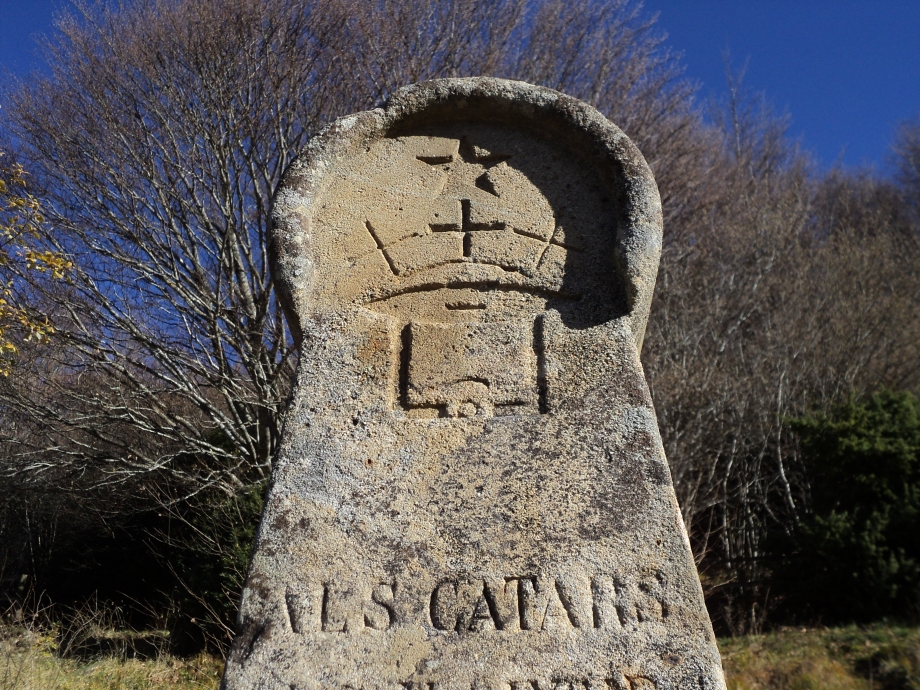
The dedication is; - "Als Catars, als martirs del pur amor chrestian, 16 mars 1244". (To the Cathars, to the martyrs of pure christian love, 16th March 1244). The message is in Occitan, the language the Cathars spoke, the date is when the Cathars were burned alive, supposedly in this very splace. Montségur, whose region was brutally taken by the King of France, has a special symbolism for the Occitan people, of a struggle to maintain their identity, which is at last solidifying through the Occitan language, its poetry and music.
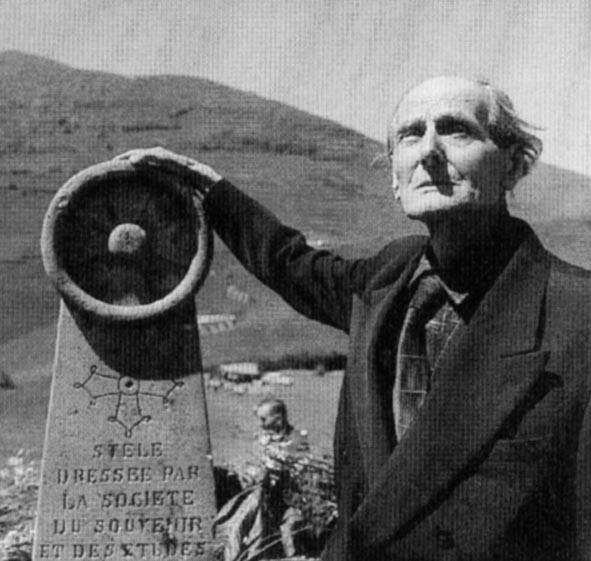
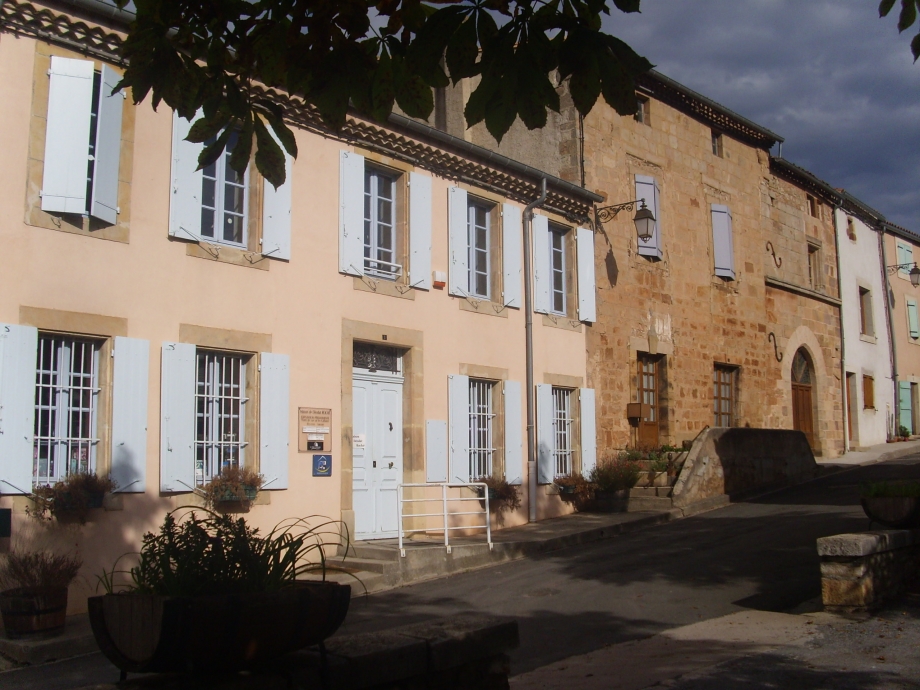
The erection and placing of this memorial was organised by Déodat Roché who used to live in Arques, not far from Rennes-le-Château on the Mouthoumet road. The picture above shows his house, it is now a museum to him. He lived to be over a hundred years old and I once met him in my previous life, which is why I wanted to visit this memorial so much. You can read more by clicking here.
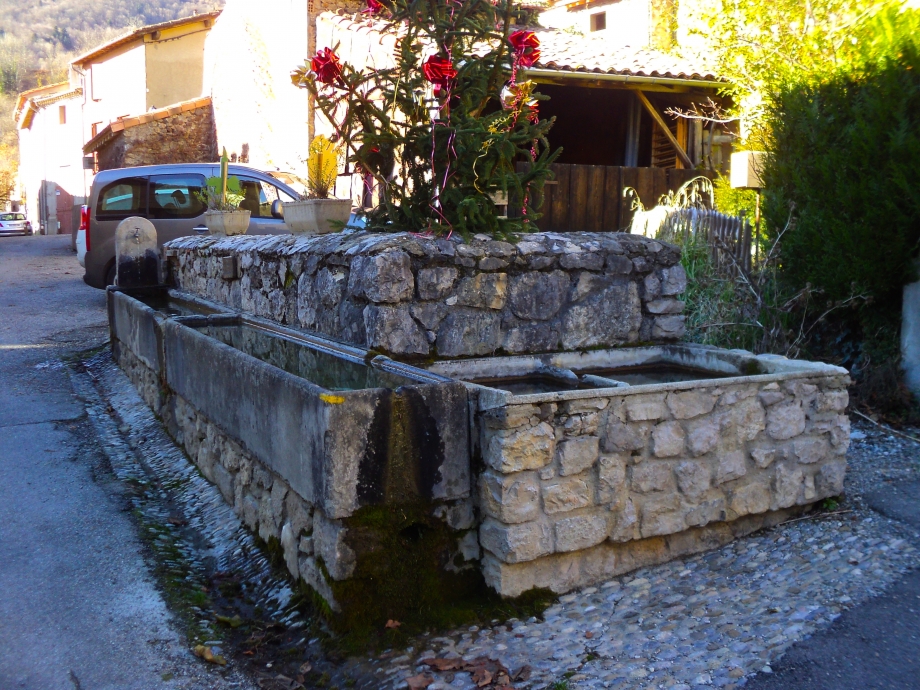
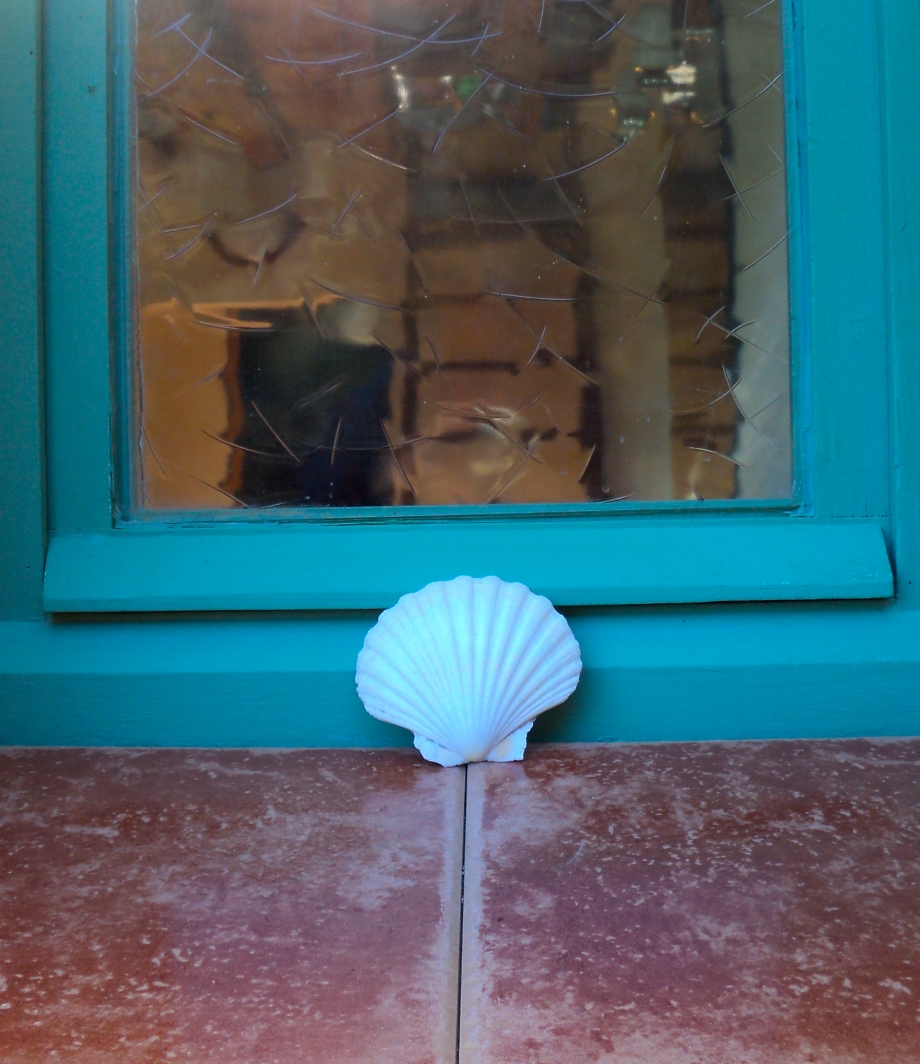
Then we went to Montségur village. It is full of water! There are four natural springs and the village holds a celebration on the 1st August every year, marking one of the four great Celtic annual festivals. The Compostela pilgrims also passed through Montségur. They could have used this old road that Richard showed us;
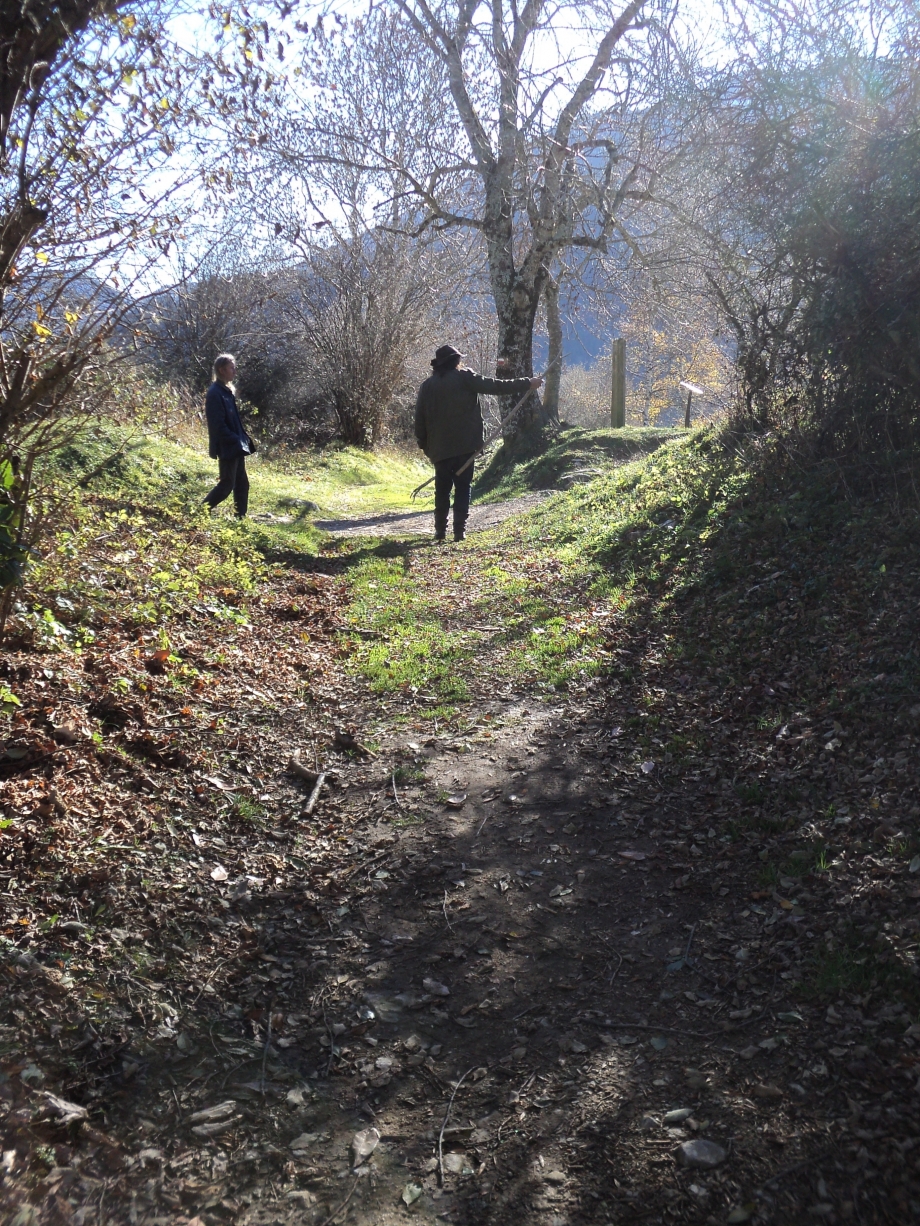
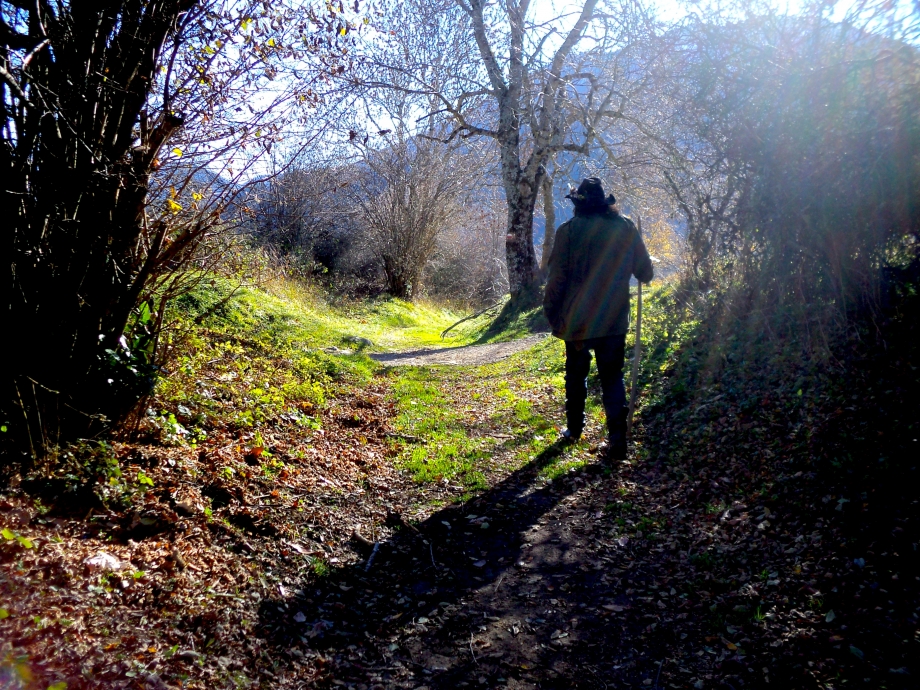
Between the car park and the Déodat Roché memorial at the foot of the mountain there is now a grassy track which was used by the Celts and Romans and travellers through the centuries; it was the only connection between Lavelanet and Montségur right up to the 1950's. I have no doubt it was originally Roman. Guillaume Azéma and Pierre Roger of Mirepoix would have come down this road to return to Montségur after the raid on Avignonet. Otto Rahn came by this road in the 1930's. It is now an official ramblers' track, the GR 7 B.
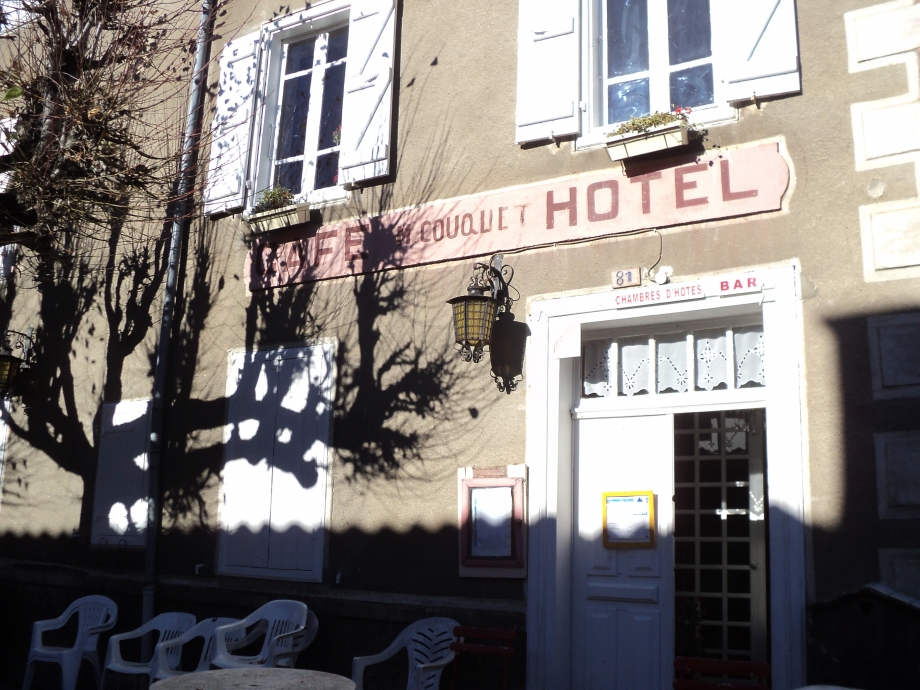
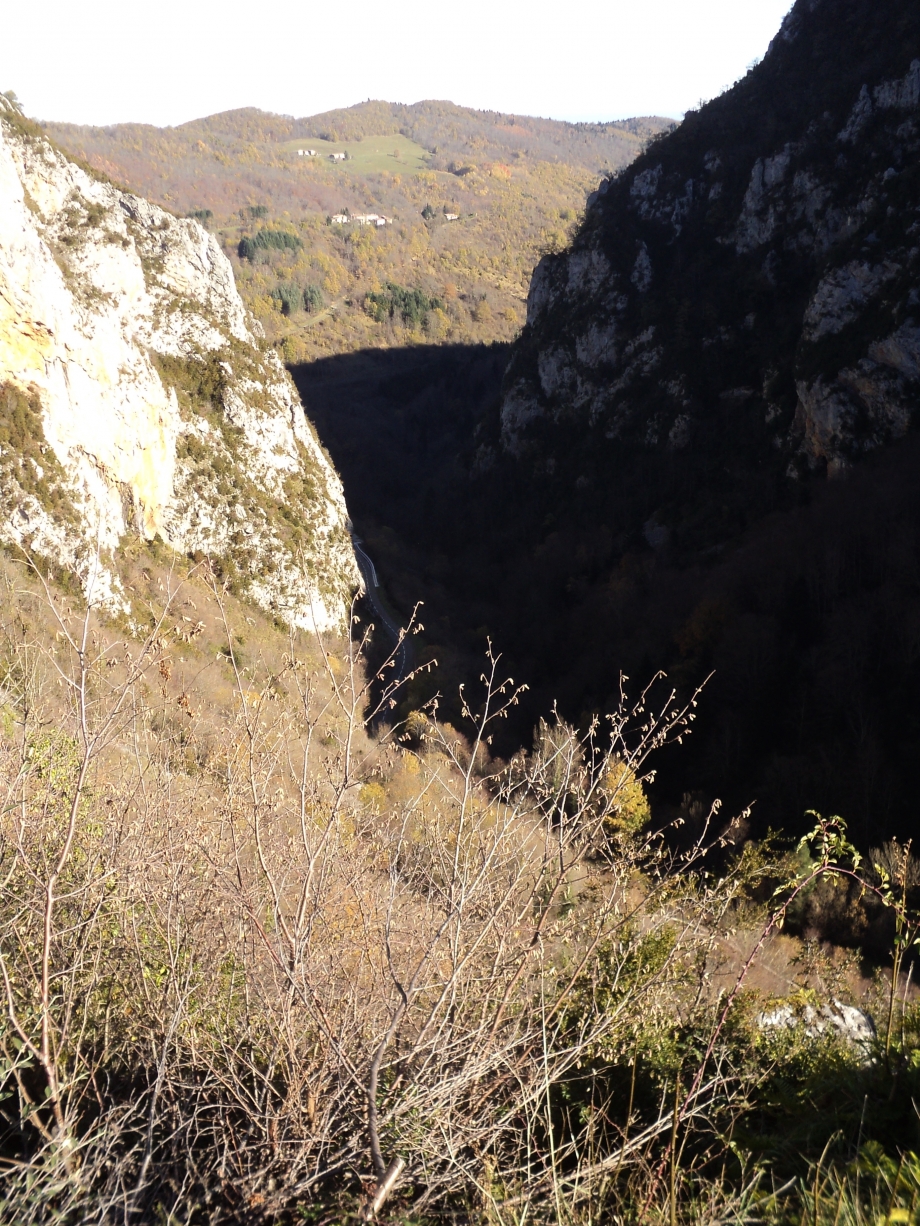
The hotel where Otto Rahn stayed and the gorge where the D9 enters the village from the north.
On the north side of the village is an area from where you can view the mountains. That day there was so little moisture in the air that shadows were quite black . . .I was fascinated (and dizzy, I have no head for heights) by the gorge entering the village from the north. The two mountainsides were sheer drops and in medieval times there were two guardhouses there, manned by the soldiers of the King, who founded today's village during the seige of the castle. No one in those sad days of 1244 could get in and out of the village but it was amazing how many people communicated with the castle all the same. I was delighted by Montségur village, even though it wasn't possible to see inside the church. God sent a message in the sky instead!
Many people who visit Rennes-le-Château also go to Montségur, 40 minutes away by car. It is the most famous Cathar castle of them all, being the last stronghold of the Cathars; the people with a Christian religion that wasn't Christian enough, and so they were burnt alive by the Inquisition.
And on the night before Montsegur was taken, and the people executed brutally for their "heresy", four courageous Cathar men abseiled down the cliff carrying the Cathar treasure to a place of safety. Some think this treasure was the Holy Grail. There is also a link to Mary Magdalene for the Cathars believed that she and Jesus were married. There is no doubt about this belief which is unique to Catharism and does not appear in any other religion.
The treasure taken from Montsegur could have been money - or it could have been a great religious secret. But what? The stories and theories are so deep . . . some people make an annual pilgrimage to Montsegur, the atmosphere of the place demands it.
Then Richard invited us to a picnic lunch - bread and salad and cheese and wine and showed us his books, collected over some thirty or more years. He is a life-long student of esoterica.
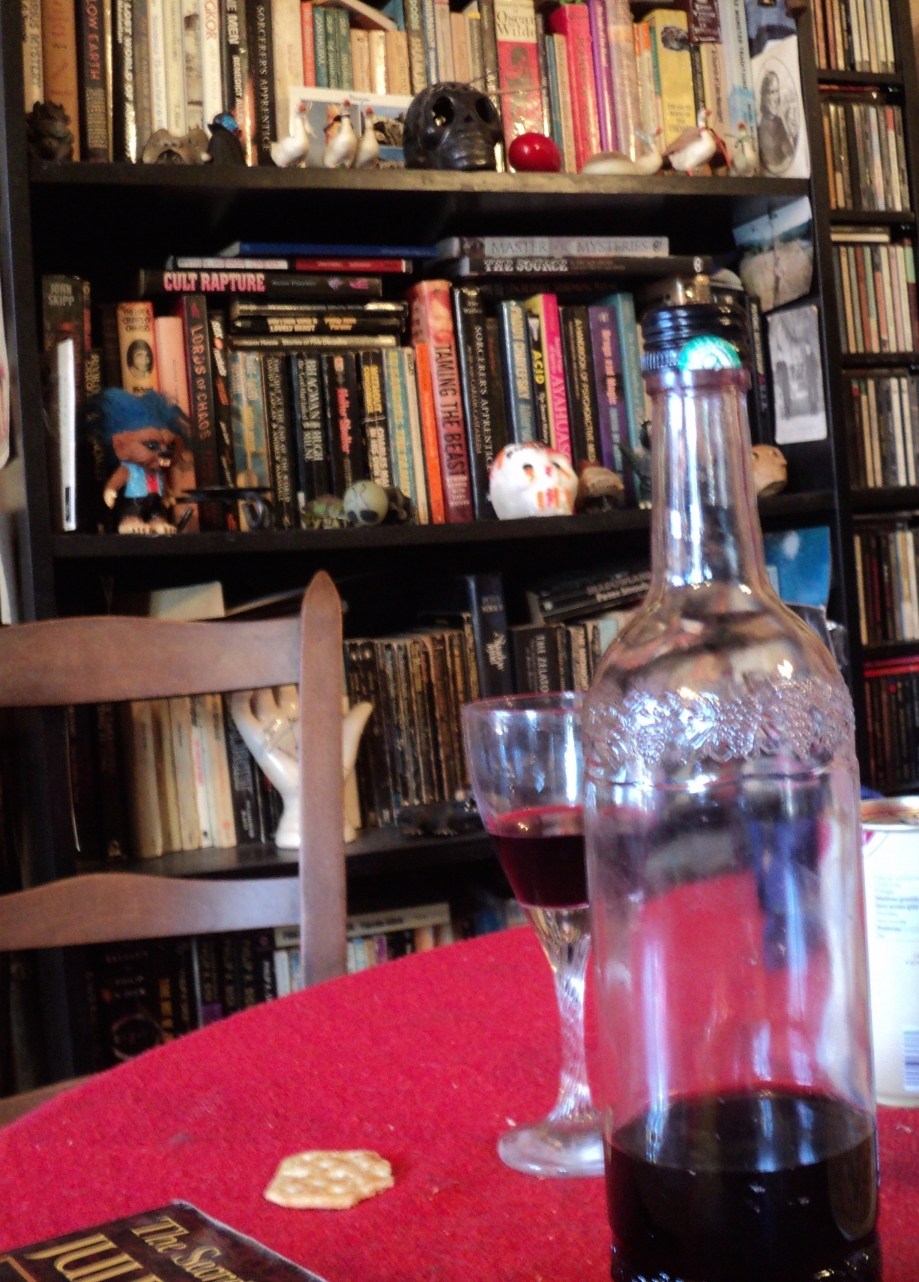
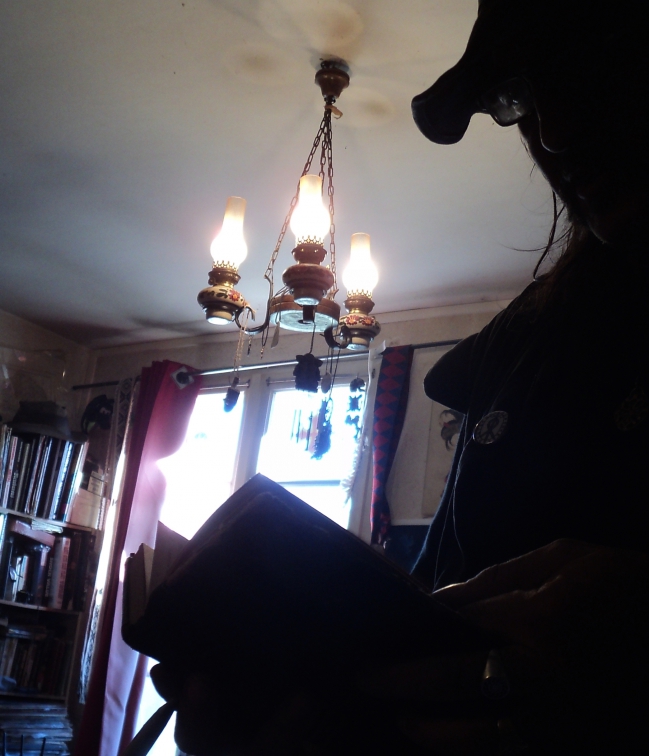
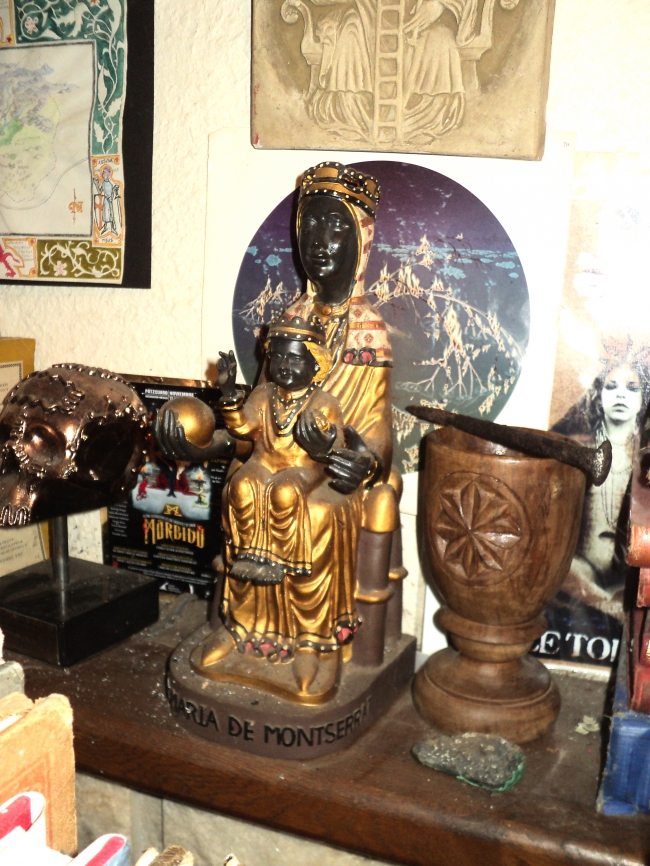
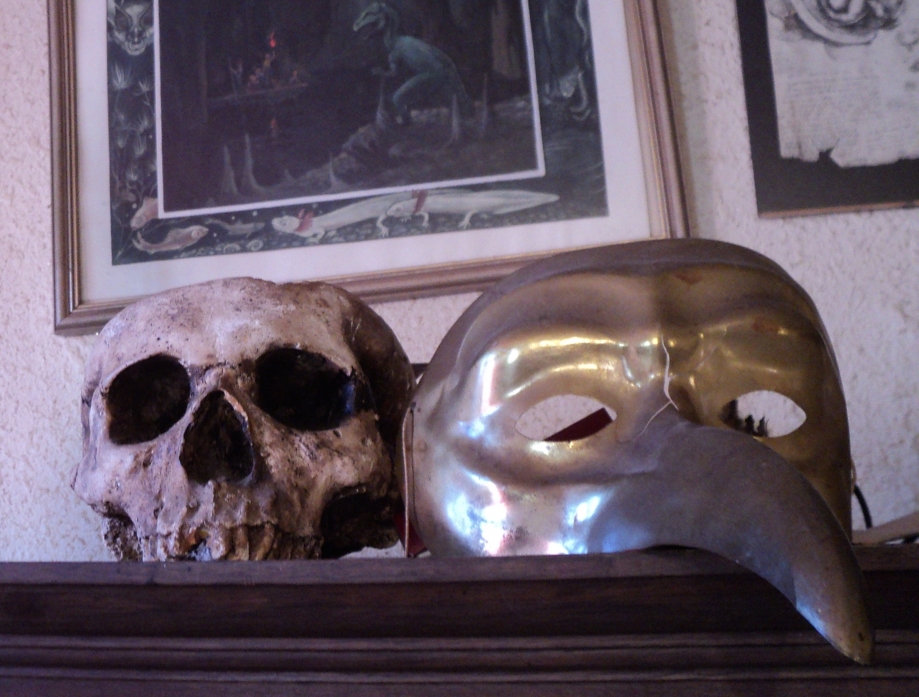
Night was falling, the wine was drunk - Hey guys, I REALLY want to see the museum! We managed to get there in time before it closed. It gives you a great insight into how it was in Cathar days that seeing the castle on its own does not.
This model clearly shows the castle was a fortified home for the lords and ladies. The garrison of soldiers lived in the courtyard.
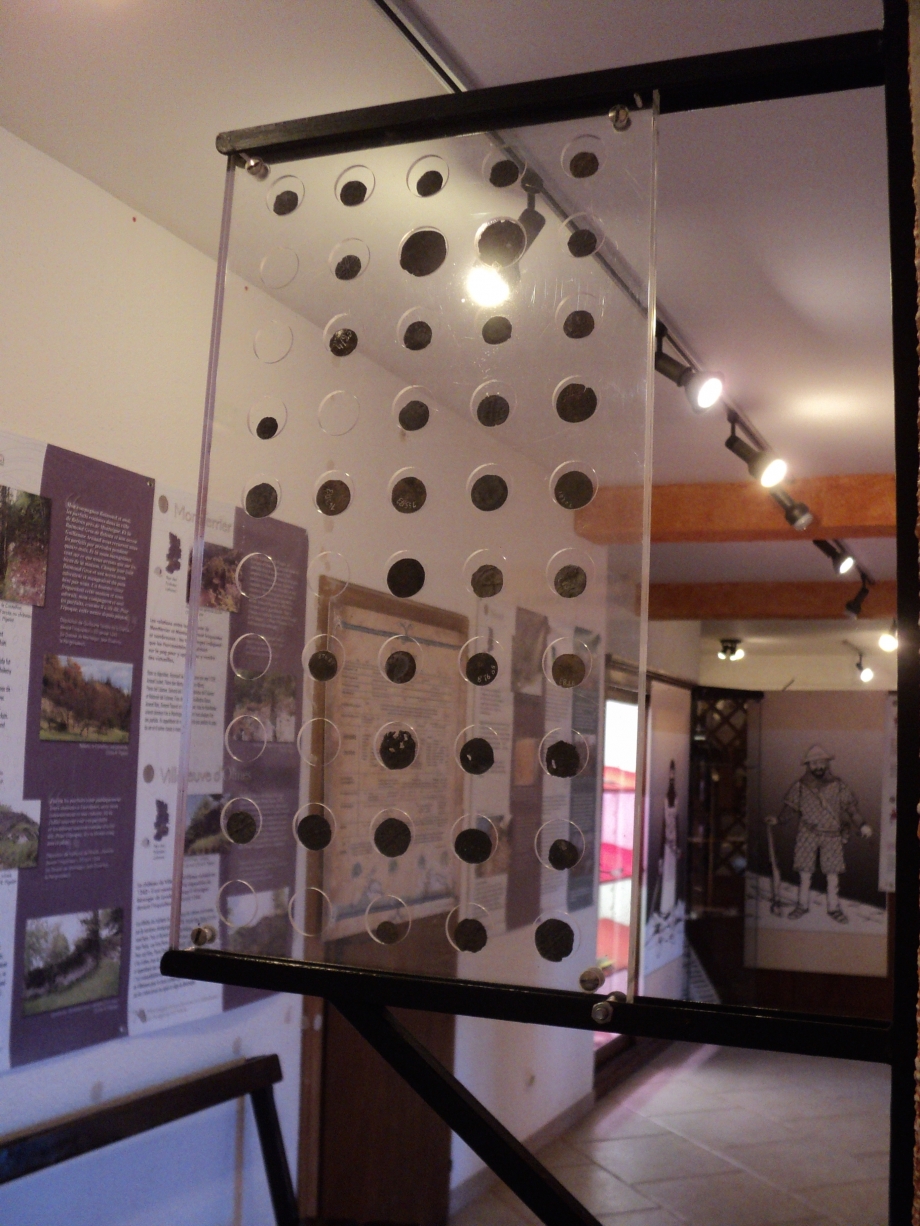
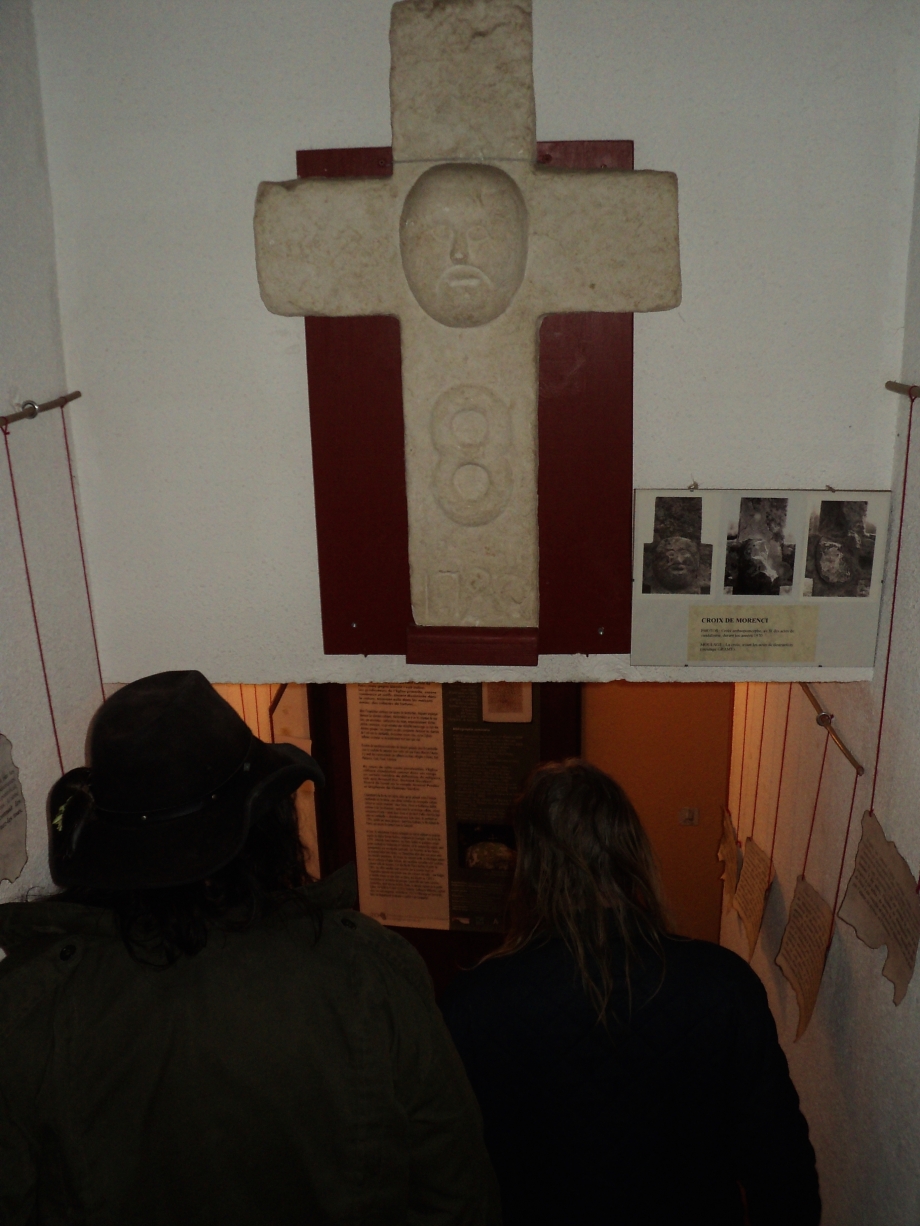
Museums always have coins and mysterious crosses, don't they?!
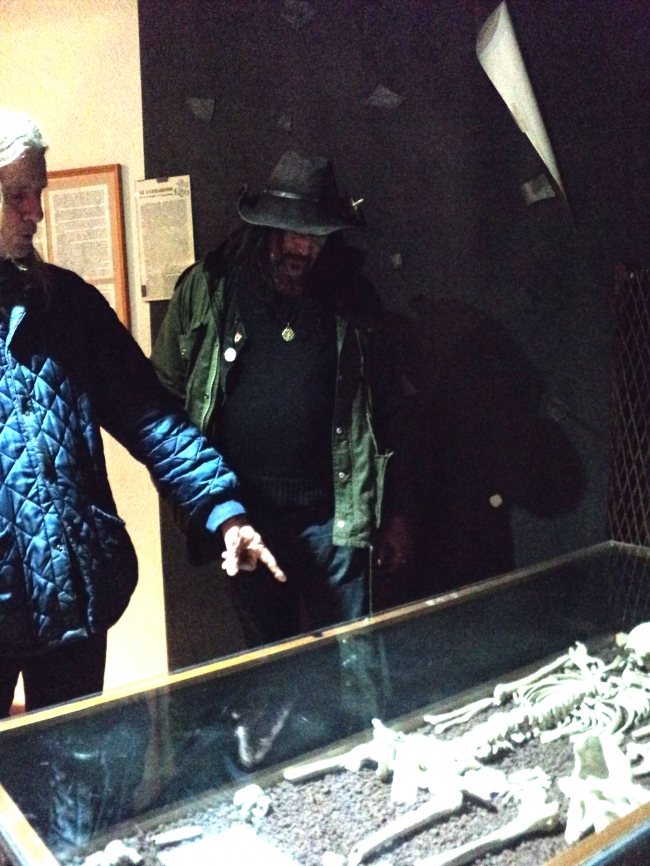
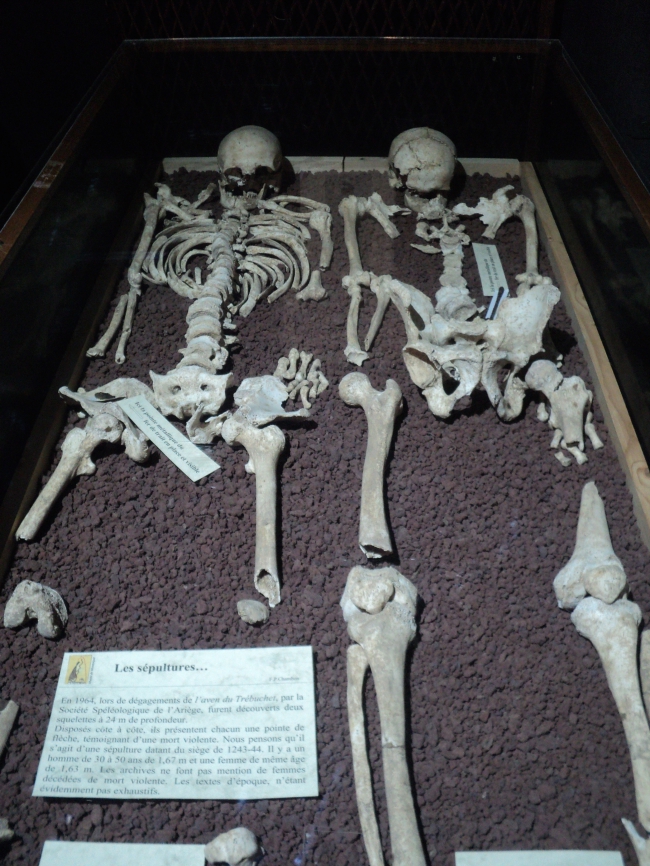
The skeletons made us pensive - the Cathars buried their dead secretly, in case the Inquisition dug them up to burn them.
As well as cannonballs and arrowheads, other archeological finds were of everyday things giving us an insight into what life was like during the seige.
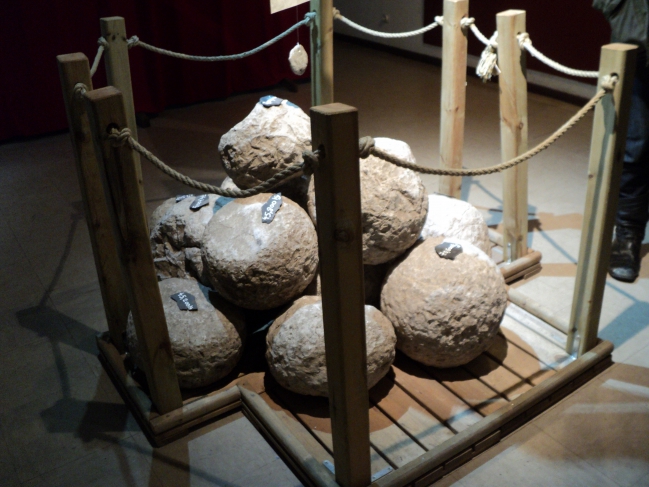
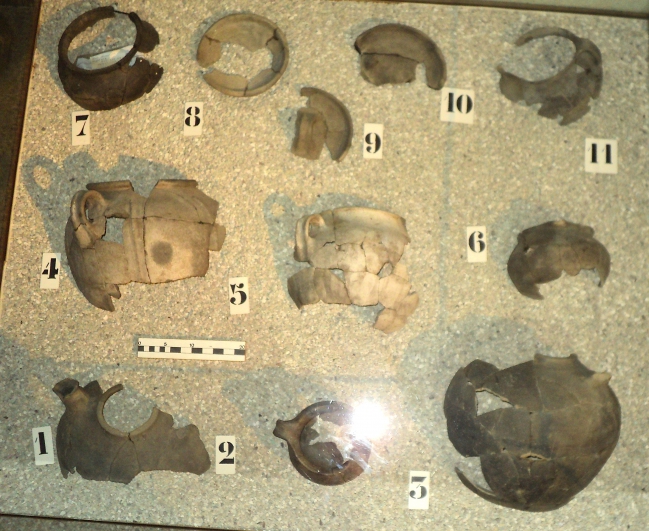
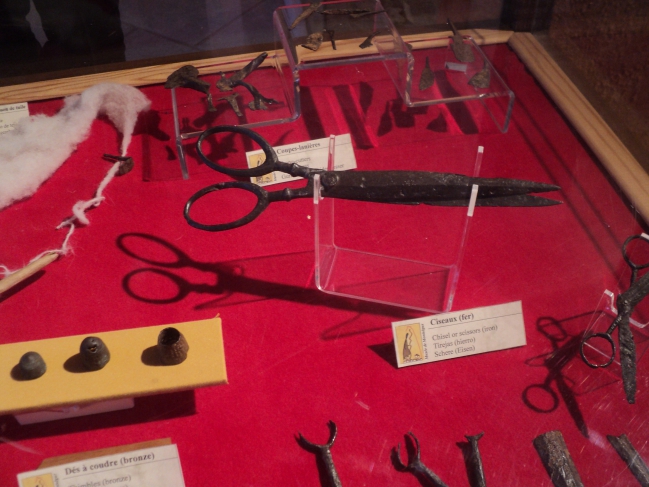
I was fascinated by the scissors. Maybe they had been used by Guillaume Azéma himself . . . The most fascinating item however, is the tiny head - of Jesus.
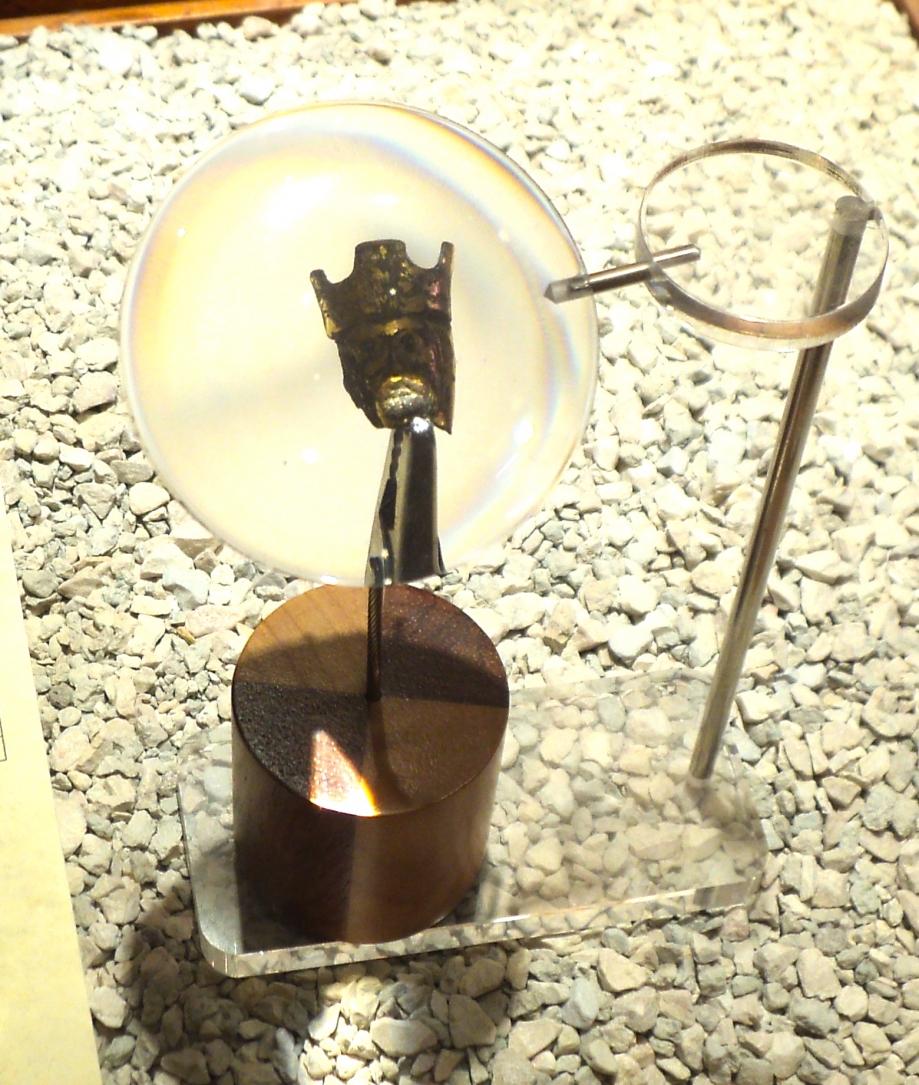
The museum is in a different place now. Not long after my visit in January 2016 it was announced there were going to be great improvements made at Montségur and much money invested, which would include a new museum. Many local people protested about the "improvements" and they managed to prevent the castle being floodlit at night, which would have destroyed the natural flora and fauna. But tourism has to be served and the new entrance from the car park at the foot of the château includes a kiosk to take an entrance fee but also "restrooms" with toilets - most practical and useful!
Then in October 2016 came more controversy.
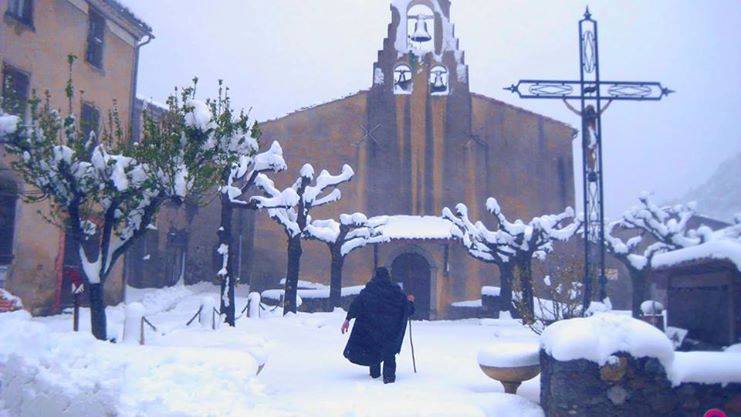
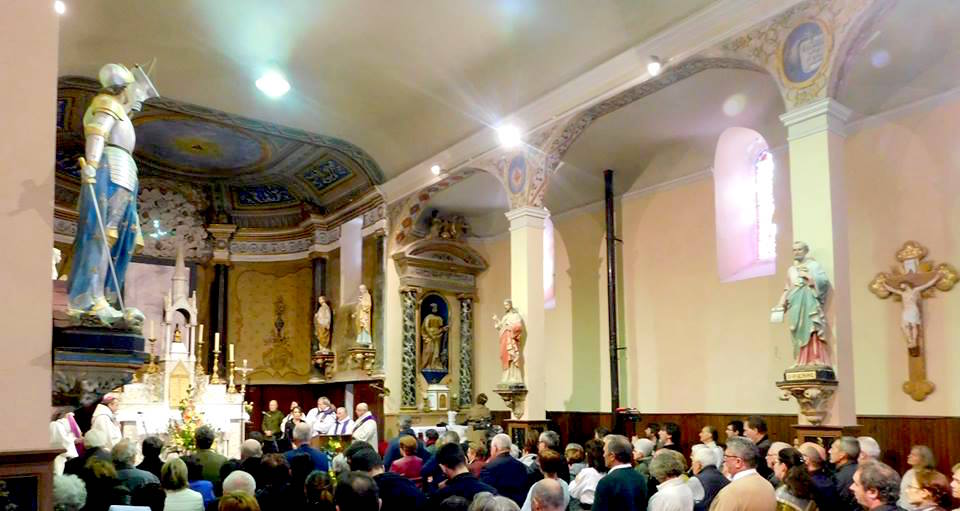
The church in winter, with thanks to Richard Stanley. The church jam-packed in October 2016, with thanks to Susie Harrison.
The Roman Church was going to apologise and ask forgiveness for their burning of the Cathars at Montségur in 1244! I could hardly believe this and thought it might be a publicity stunt to promote the Church. Certainly, people could only enter the church that day if they were in possession of a formal invitation; everybody else had to sit under an awning outside, and even that wasn't big enough, because more than 500 people came to the event. There were rumours of feet-washing to take place as a sign of humility but this didn't happen . . .
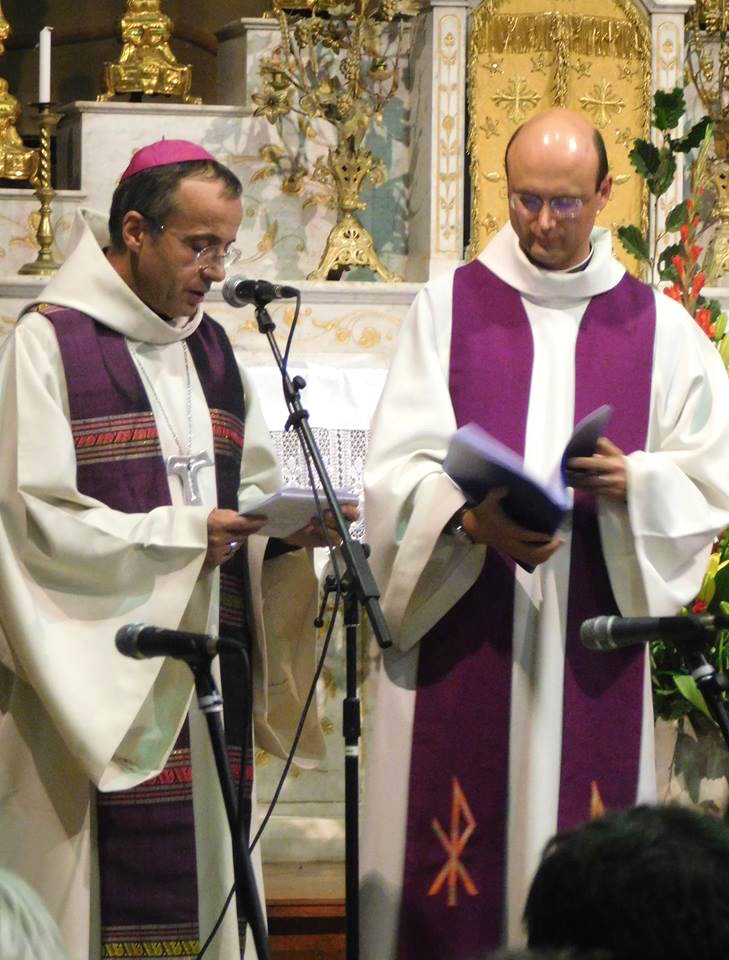
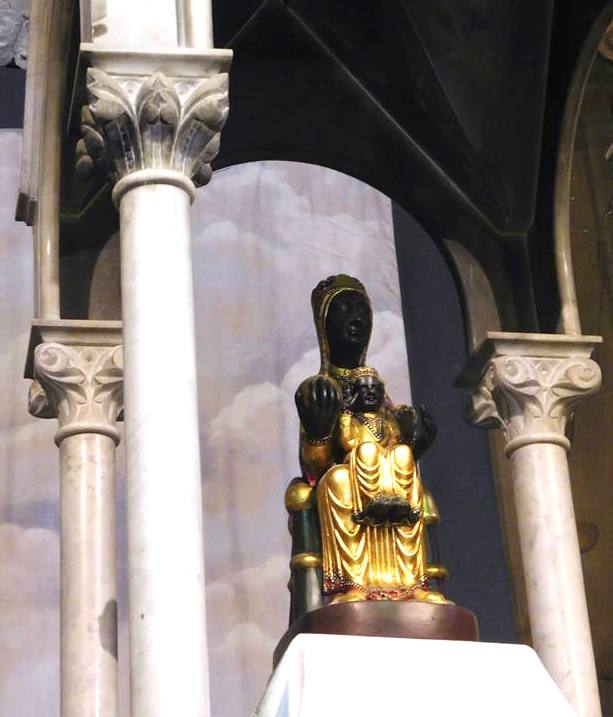
Thanks to Susie Harrison for the photos
The Bishop of Pamiers, who was acting on his own behalf, not on behalf of the Church as a whole, gave his talk and read from St. Matthew's gospel about forgiveness, overlooked by the tiny Black Madonna, a copy of the one originally found at Montserrat in the Pyrenees. Montségur and the Cathars has always been closely associated with the Occitan language and the region of Occitania, which was today's Languedoc and not, at the time of the Cathars, part of France. The bishop, of Couserans and Mirepoix as well as Pamiers, was supported by father Edward De Laportalière, the priest at nearby Lavelanet. Then they knelt in front of the altar "as a sign of repentence" said one of the local papers. "We apologize, first to the Lord, but also to all those as members of our church were then persecuted," said the Bishop. Then a lady sang beautiful songs in Occitan.
Not everybody was perfectly happy, however. An association dedicated to "maintaining the Occitan tradition" thought the apology was a bit late after 772 years. Their president added; "This is a pardon but it is not reconciliation." Some were disappointed that this was a very local event and not more widespread through Occitania.
I wasn't able to go personally but my friends who did go, however, were delighted. Everyone thought of the prediction of Bélibaste, the last Pefect who was burned alive, who declared as they lit the brushwood, "after 700 years the laurel will bloom again." They carried laurel branches and then most of the people at the event walked up to the castle. Susie told me it was a very moving event. "Someone I know spent some of the next day with the local priest," she added, "who was much behind the scenes of what happened, and told my friend that his own ancestors had died in the fires of Montségur."
Many friends told me the feeling of the day was "very loving and positive."
Inscrivez-vous au blog
Soyez prévenu par email des prochaines mises à jour
Rejoignez les 28 autres membres

